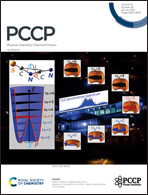The relationship between the local environment, N-type, spin state and catalytic functionality of carbon-hosted FeII/III–N4 for the conversion of CO2 to CO†
Abstract
Iron and nitrogen codoped carbon (Fe–N–C) materials are promising alternatives to precious metal catalysts for the carbon dioxide electrochemical reduction reaction (CO2RR); however, the influence of the oxidation state, spin state, N-type and local environment of Fe–N on its catalytic activity remains poorly understood. In this study, we employed density functional theory (DFT) calculations to evaluate the catalytic activity of the pyridine-type FeIII/IIN4 motifs at the armchair and zigzag edges, the activity of the pyrrole-type FeIII/IIN4 sites in the bulk plane of carbon-based materials for the two-electron CO2RR by analyzing the stability of initial reactants, free-energy evolutions and energy barriers for the possible elementary reactions in the different spin states. The Fe ions in the armchair-edge pyridine-type FeN4 are mainly in the +2 oxidation state, and use the high spin state in the spin uncoupling manner to achieve the most efficient CO2–COOH–CO conversion. In contrast, the zigzag-edge pyridine-type FeIIN4 employs the medium spin state in the spin uncoupling manner to achieve the highest catalytic activity in the two-electron CO2RR. However, the Fe ions in the pyrrole-type bulk-hosted FeN4 mainly remain in the +3 valence state during the conversion process of CO2 to CO and utilize the medium spin state with spin coupling to obtain the highest catalytic activity. The corresponding kinetic analyses show that the armchair-edge pyridine-type FeIIN4 catalyst exhibited the best catalytic performance among the three cases. Consequently, these findings present significant insights into the design of Fe single-atom catalysts for enhancing CO2RR catalytic activity by producing more armchair-edge pyridine-type FeN4 sites, which may be constructed by introducing micropores in the carbon materials.



 Please wait while we load your content...
Please wait while we load your content...